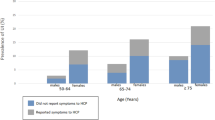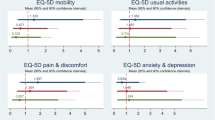Abstract
Introduction and Hypothesis
The world including Iran is facing population aging. Urinary incontinence (UI) is one of the most common health concerns of older women that can be accompanied by an increased sense of loneliness, social restrictions, and disruption in activities of daily living in addition to the regular challenges of old age. This study was aimed at explaining the concerns of community-dwelling older women living with UI.
Methods
This study used the conventional, qualitative, content analysis approach with purposive sampling. Twenty interviews were conducted with 18 participants, including 15 community-dwelling older women with UI and three family members (a husband and two daughters), over the span of 14 months (from August 2021 to October 2022). The data were collected via semi-structured, face-to-face interviews until data saturation was achieved, and were analyzed using Graneheim and Lundman’s method.
Results
The findings revealed that the concerns of older women with UI include the impasse of UI, being powerless in life, distorted social identity, and marital frustration, which fell under the main theme of sense of inadequacy.
Conclusions
Recognizing the concerns of older women with UI can make health care teams more sensitive to the importance of resolving these concerns and can offer some insight into how best to provide targeted training, support, and counseling services at individual, family, and society levels, to eventually resolve the older adult’s sense of inadequacy.
Similar content being viewed by others
Data availability
The datasets generated and analyzed during the current study are not publicly available owing to an agreement with the participants on the confidentiality of the data, but are available from the corresponding author on reasonable request.
References
Statistical Centre of Iran. Selected Findings of the 2016 National Population and Housing Census. Vice Presidency Plan and Budget Organization. 2019. Available online at: https://www.amar.org.ir/Portals/1/census/2016/Census_2016_Selected_Findings.pdf. Accessed 22 June 2021.
Devi BN, Megala M, Saravanakumar P. Social and health concerns of elderly women in rural area in Tirupur District, Tamil Nadu. J Family Med Prim Care. 2022;11(8):4447. https://doi.org/10.4103/jfmpc.jfmpc_42_22.
Murukesu RR, Singh DK, Shahar S. Urinary incontinence among urban and rural community dwelling older women: prevalence, risk factors and quality of life. BMC Public Health. 2019;19(4):529. https://doi.org/10.1186/s12889-019-6870-6.
Tsuchiya Y, Shida N, Tsujiuchi T, Machida K. Healthy aging and concerns among elderly Japanese: a text analysis approach. Int Q Commun Health Educ. 2015;35(3):215–26. https://doi.org/10.1177/0272684x15576515.
Kim O, Dan H. Experience of elderly Korean women with diabetes and multimorbidity in elderly couple households: a qualitative study. Healthcare. 2022;10(9):1675. https://doi.org/10.3390/healthcare10091675.
Dumoulin C, Morin M, Danieli C, et al. Group-based vs individual pelvic floor muscle training to treat urinary incontinence in older women: a randomized clinical trial. JAMA Intern Med. 2020;80(10):1284–93. https://doi.org/10.1001/jamainternmed.2020.2993.
Abrams P, Cardozo L, Fall M, et al. The standardization of terminology of lower urinary tract function: report from the standardization sub-committee of International Continence Society. Textbook of female urology and urogynecology. Boca Raton: CRC Press; 2010.
Batmani S, Jalali R, Mohammadi M, Bokaee S. Prevalence and factors related to urinary incontinence in older adults women worldwide: a comprehensive systematic review and meta-analysis of observational studies. BMC Geriatr. 2021;21(1):1–17. https://doi.org/10.1186/s12877-021-02135-8.
Morowatisharifabad MA, Rezaei PH, Mazyaki A, Bandak Z. Prevalence of urinary incontinence among elderly women in Yazd, Iran: a population-based study. Elder Health J. 2015;1(1):27–31.
Delarmelindo RCA, de Lima Parada CMG, Rodrigues RAP, Bocchi SCM. Estratégias de enfrentamento da incontinência urinária por mulheres. Rev Esc Enfer USP. 2013;47(2):296–303. https://doi.org/10.1590/S0080-62342013000200004.
Halter JB. Hazzard’s geriatric medicine and gerontology. 6th ed. New York: McGraw-Hill; 2009.
Fouad R, Hafez S. Elderly urinary incontinence, self esteem and quality of life. Alex Sci Nurs J. 2017;19(1):91–108.
Pakgohar M, Hamid T-A, Ibrahim R, Vahid-Dastjerdi M. Portrait representation of postmenopausal women’s experiences of living with urinary incontinence. J Women Aging. 2015;27(1):81–95. https://doi.org/10.1080/08952841.2014.928145.
Lee HY, Rhee Y, Choi KS. Urinary incontinence and the association with depression, stress, and self-esteem in older Korean Women. Sci Rep. 2021;11(1):9054.
Rada MP, Jones S, Betschart C, et al. A meta-synthesis of qualitative studies on stress urinary incontinence in women for the development of a Core Outcome Set: a systematic review. Int J Gynecol Obstet. 2022;158(1):3–12. https://doi.org/10.1002/ijgo.13934.
Yang E, Lisha NE, Walter L, Obedin-Maliver J, Huang AJ. Urinary incontinence in a national cohort of older women: implications for caregiving and care dependence. J Womens Health (Larchmt). 2018;27(9):1097–103. https://doi.org/10.1089/jwh.2017.6891.
Hakimi S, Aminian E, Mohammadi M, Mohammad Alizadeh S, Bastani P, Houshmandi S. Prevalence and risk factors of urinary/anal incontinence and pelvic organ prolapse in healthy middle-aged Iranian women. J Menopausal Med. 2020;26(1):24–8. https://doi.org/10.6118/jmm.19201.
Mishra GD, Kumar D, Pathak GA, Vaishnav BS. Challenges encountered in community-based physiotherapy interventions for urinary incontinence among women in rural areas of Anand District of Gujarat, India. Indian J Public Health. 2020;64(1):17–21. https://doi.org/10.4103/ijph.ijph_436_18.
Mendes A, Hoga L, Gonçalves B, Silva P, Pereira P. Adult women’s experiences of urinary incontinence: a systematic review of qualitative evidence. JBI Database System Rev Implement Rep. 2017;15(5):1350–408. https://doi.org/10.11124/jbisrir-2017-003389.
Javanmardifard S, Gheibizadeh M, Shirazi F, Zarea K, Ghodsbin F. Psychosocial experiences of older women in the management of urinary incontinence: a qualitative study. Front Psychol. 2022;13: 785446. https://doi.org/10.3389/fpsyg.2022.785446.
Gjerde JL, Rortveit G, Muleta M, Blystad A. Silently waiting to heal: experiences among women living with urinary incontinence in northwest Ethiopia. Int Urogynecol J. 2013;24:953–8. https://doi.org/10.1007/s00192-012-1951-4.
Javanmardifard S, Gheibizadeh M, Shirazi F, Zarea K, Ghodsbin F. Experiences of urinary incontinence management in older women: a qualitative study. Front Public Health. 2022;9:738202. https://doi.org/10.3389/fpubh.2021.738202.
Mack N, Woodsong C, Macqueen KM, Guest G, Namey EE. Qualitative research methods. A data collector’s field guide. Durham, NC: Family Health International; 2005.
Graneheim UH, Lundman B. Qualitative content analysis in nursing research: concepts, procedures and measures to achieve trustworthiness. Nurse Educ Today. 2004;24(2):105–12. https://doi.org/10.1016/j.nedt.2003.10.001.
Hajebrahimi S, Nourizadeh D, Hamedani R, Pezeshki MZ. Validity and reliability of the International Consultation on Incontinence Questionnaire-Urinary Incontinence Short Form and its correlation with urodynamic findings. Urol J. 2012;9(4):685–90. https://doi.org/10.22037/uj.v9i4.1800.
Horrocks S, Somerset M, Stoddart H, Peters TJ. What prevents older people from seeking treatment for urinary incontinence? A qualitative exploration of barriers to the use of community continence services. Fam Pract. 2004;21(6):689–96. https://doi.org/10.1093/fampra/cmh622.
Wang C, Li J, Wan X, Wang X, Kane RL, Wang K. Effects of stigma on Chinese women’s attitudes towards seeking treatment for urinary incontinence. J Clin Nurs. 2015;24(7–8):1112–21. https://doi.org/10.1111/jocn.12729.
Park S, Yeoum S, Kim Y, Kwon HJ. Self-management experiences of older Korean women with urinary incontinence: a descriptive qualitative study using focus groups. J Wound Ostomy Continence Nurs. 2017;44(6):572–7.
Cheng S, Lin D, Hu T, et al. Association of urinary incontinence and depression or anxiety: a meta-analysis. J Int Med Res. 2020;48(6):0300060520931348. https://doi.org/10.1177/0300060520931348.
Al-Badr A, Brasha H, Al-Raddadi R, Noorwali F, Ross S. Prevalence of urinary incontinence among Saudi women. Int J Gynecol Obstet. 2012;117(2):160–3. https://doi.org/10.1016/j.ijgo.2011.12.014.
Treister-Goltzman Y, Peleg R. Urinary incontinence among Muslim women in Israel: risk factors and help-seeking behavior. Int Urogynecol J. 2018;29:539–46. https://doi.org/10.1007/s00192-017-3438-9.
Lee JJ. The relationship between gender and the psychological impact of urinary incontinence on older people in Hong Kong: an exploratory analysis. Ageing Soc. 2004;24(4):553–66. https://doi.org/10.1017/S0144686X03001612.
Stadnicka G, Łepecka-Klusek C, Pilewska-Kozak A, Jakiel G. Psychosocial problems of women with stress urinary incontinence. Ann Agric Environ Med. 2015;22(3):499–503. https://doi.org/10.5604/12321966.1167723.
Wang YH, Chen SH, Jou HJ, Tsao LI. Doing the best to control: the experiences of Taiwanese women with lower urinary tract symptoms. Nurs Res. 2011;60(1):66–72. https://doi.org/10.1097/nnr.0b013e3181ff72ec.
Hägglund D, Ahlström G. The meaning of women’s experience of living with long-term urinary incontinence is powerlessness. J Clin Nurs. 2007;16(10):1946–54. https://doi.org/10.1111/j.1365-2702.2007.01787.x.
Kohler M, Mayer H, Kesselring J, Saxer S. (Can) Not talk about it–urinary incontinence from the point of view of stroke survivors: a qualitative study. Scand J Caring Sci. 2018;32(1):371–9. https://doi.org/10.1111/scs.12471.
Chui RCF. The role of meaning in life for the quality of life of community-dwelling Chinese elders with low socioeconomic status. Gerontol Geriatr Med. 2018;4:2333721418774147. https://doi.org/10.1177/2333721418774147.
Toye F, Barker KL. A meta-ethnography to understand the experience of living with urinary incontinence: ‘is it just part and parcel of life?’ BMC Urol. 2020;20:1–25. https://doi.org/10.1186/s12894-019-0555-4.
Southall K, Tuazon JR, Djokhdem AH, van den Heuvel EA, Wittich W, Jutai JW. Assessing the stigma content of urinary incontinence intervention outcome measures. J Rehabil Assist Technol Eng. 2017;4:2055668317738943. https://doi.org/10.1177/2055668317738943.
Brittain KR, Shaw C. The social consequences of living with and dealing with incontinence—a carers perspective. Soc Sci Med. 2007;65(6):1274–83. https://doi.org/10.1016/j.socscimed.2007.04.002.
Lobchuk MM, Rosenberg F. A qualitative analysis of individual and family caregiver responses to the impact of urinary incontinence on quality of life. J Wound Ostomy Continence Nurs. 2014;41(6):589–96.
Dekker J, de Groot V. Psychological adjustment to chronic disease and rehabilitation–an exploration. Disabil Rehabil. 2018;40(1):116–20. https://doi.org/10.1080/09638288.2016.1247469.
Acknowledgements
This research is part of a doctoral dissertation. The authors wish to express their gratitude to the Deputy of Research of Semnan and Rofiedeh Rehabilitation Hospital for supporting this project.
Funding
The authors received no financial support for the research, authorship, and/or publication of this article.
Author information
Authors and Affiliations
Contributions
All authors have accepted responsibility for the entire content of this manuscript and approved its submission.
E.T.: conceptualization, methodology, investigation, data curation, writing the original draft, writing review and editing; M.N.: conceptualization, methodology, investigation, data curation, writing the original draft, writing review and editing, supervision, project administration; M.F.: conceptualization, data curation, writing the original draft, writing review and editing; M.R.A.: conceptualization, data curation, writing the original draft, writing review and editing.
Corresponding author
Ethics declarations
Conflicts of Interest
The authors declare that they have no conflicts of interest.
Additional information
Handling Editor: Gin-Den Chen
Editor in Chief: Maria A. Bortolini
Publisher's Note
Springer Nature remains neutral with regard to jurisdictional claims in published maps and institutional affiliations.
Rights and permissions
Springer Nature or its licensor (e.g. a society or other partner) holds exclusive rights to this article under a publishing agreement with the author(s) or other rightsholder(s); author self-archiving of the accepted manuscript version of this article is solely governed by the terms of such publishing agreement and applicable law.
About this article
Cite this article
Talebi, E., Nobahar, M., Foroughan, M. et al. The Concerns of Community-Dwelling Older Women Living with Urinary Incontinence: Qualitative Research. Int Urogynecol J (2024). https://doi.org/10.1007/s00192-024-05810-7
Received:
Accepted:
Published:
DOI: https://doi.org/10.1007/s00192-024-05810-7




